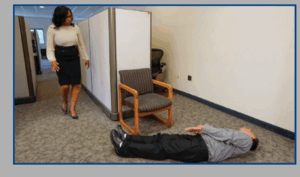
A New Zealand Perspective
Epilepsy affects approximately 1 in every 100 Kiwis — that’s over 47,000 people across Aotearoa. While many live full, active lives, seizures can happen suddenly, often in public places like workplaces, schools, or homes.
But here’s the key question: Would you know what to do if someone had a seizure right in front of you?
Knowing how to respond can save a life — and it starts with the right first aid training.
⚡ What Does a Seizure Look Like?
A tonic-clonic seizure (commonly known as a convulsion) is often the most visible type:
- Sudden collapse
- Body stiffening
- Jerking movements
- Loss of consciousness
- Possible loss of bladder control
Other seizure types can be more subtle, such as blank staring, confusion, or repetitive movements. No matter the type, calm, informed action is critical.

Credit: Epilepsy Waikato Charitable Trust
🩺 Basic Seizure First Aid (NZ Guidelines)
According to Epilepsy NZ, KidsHealth NZ, and Medic First Aid, these are the key steps:
✅ DO:
- Stay calm and time the seizure
- Protect from injury: remove sharp objects nearby, cushion their head
- Once jerking stops, roll them into the recovery position
- Stay with them until fully alert
- Call 111 if:
- The seizure lasts more than 5 minutes
- They have another seizure immediately
- They don’t regain consciousness
- It’s their first seizure
❌ DON’T:
- Don’t restrain their movements
- Don’t put anything in their mouth
- Don’t try to give food, drink, or medication until they’re fully alert
📄 Download a free NZ seizure first aid poster:
Seizure First Aid Plan – KidsHealth NZ
🧪 Why First Aid Training Matters
Many people still do the wrong thing during a seizure, often due to fear or outdated myths (like putting something in the person’s mouth). Formal training:
- Builds confidence to act under pressure
- Teaches correct recovery techniques
- Prepares you for different types of seizures
- Empowers you to help whānau, colleagues, or strangers
🎓 Where to Learn Seizure First Aid in New Zealand
- Medic First Aid Courses
- In-person or blended courses
- Includes seizure response, CPR, choking, and more
🔗 Explore courses at Medic First Aid
- Epilepsy New Zealand – SeizureSmart Online Course
- Free, self-paced, NZ-based
- Learn seizure types, emergency response, and care planning
- For Parents & Schools – KidsHealth NZ
- Clear, parent-friendly advice
- Emergency seizure medication guidance
🏫 Make Your Community Seizure Smart
Here’s how to help build a more prepared and supportive Aotearoa:
| Action | Impact |
| ✅ Take a seizure first aid course | Gain confidence, stay prepared |
| 🧒 Teach children & caregivers | Empower tamariki & teachers |
| 📌 Display seizure posters | Reinforce correct response steps |
| 🧾 Add epilepsy info to your emergency plan | Safer workplaces, schools, clubs |
| 💬 Talk about it | End stigma, raise awareness |
🌿 Final Thoughts
A seizure can happen anywhere — on a rugby field, in a café, at school, or in your own home. When it does, knowing how to respond calmly and correctly makes all the difference.
By taking a first aid course and sharing what you’ve learned, you help create a Safer, SeizureSmart New Zealand for everyone.
📚 Useful Links
Medic First Aid NZ First Aid Courses
Seizure Diagrams & Info – Epilepsy Waikato

